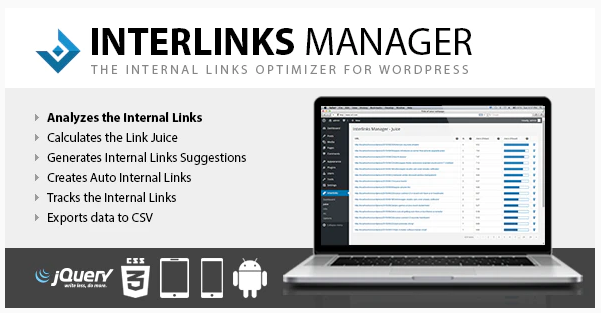The Interlinks Manager plugin appears to be a tool designed to help website owners and content creators improve their website’s internal linking structure for the purpose of enhancing SEO and user experience.
The plugin provides a set of tools to facilitate the development of an effective internal linking strategy. Here’s an overview of its key features:
- Internal Linking Strategy: The plugin focuses on optimizing the way internal links are utilized within your website’s content. Internal linking involves creating links from one page or post on your website to another page or post on the same website.
- SEO Benefits: An optimized internal linking structure can have positive effects on your website’s SEO. It helps search engines understand the relationship between different pages and posts, which can contribute to better indexation and ranking.
- Relevance and Naturalness: The plugin aims to strike a balance between relevance for search engines and naturalness for readers. Effective internal linking connects related content in a way that makes sense to users while providing search engines with valuable signals about content hierarchy.
- Increased Website Visits: By strategically linking relevant content, the plugin intends to encourage visitors to explore more pages and spend more time on your website, potentially leading to increased pageviews and engagement.
- Conversion and Sales: Improved internal linking can also guide users towards important conversion pages, such as product pages or landing pages, potentially boosting conversions and sales.
- Tools for Development: The plugin likely provides tools to help you identify suitable pages for internal linking, suggest relevant anchor text, and manage the internal links across your website.
- User-Friendly Interface: A user-friendly interface can simplify the process of creating and managing internal links, making it accessible to both experienced SEO practitioners and beginners.
- Customization: Depending on the plugin’s features, you might be able to customize the number of internal links on each post, the anchor text used, and the types of pages/posts linked.
- Analytics and Insights: Some advanced plugins might offer analytics or insights related to how internal links are performing, such as click-through rates or engagement metrics.
Optimizing internal links is indeed an important SEO strategy that can enhance user experience, improve site structure, and contribute to search engine ranking. However, it’s important to use such tools judiciously. Internal links should always be contextually relevant, and their primary purpose should be to provide value to readers. Over-optimization or excessive internal linking can have negative consequences, including confusing readers and potentially attracting penalties from search engines.
Before using any plugin or tool, it’s advisable to review its documentation, user reviews, and best practices to ensure that it aligns with your website’s goals and SEO strategy.
Analyze the interlinks
Inside the Dashboard menu, with regular expressions applied to your posts, and by tracking the users clicks, this plugin is able to retrieve information such as the number of manual internal links, the number of auto internal links, the number of visits generated with your internal links, the optimization status and more.
With these information at your disposal will be easy for you to add or remove internal links when needed, and always keep an optimized number of internal links in every post.
Calculate the link juice
The Juice menu gives you information about the flow of link juice on the URLs of your website, and provides, for each URL, a detailed list of all the single links that contribute to generate the overall link juice.
“Explore our wide range of categories and discover the perfect project or software tailored to your preferences. Your ideal choice awaits your visit!” https://topnewcode.com




